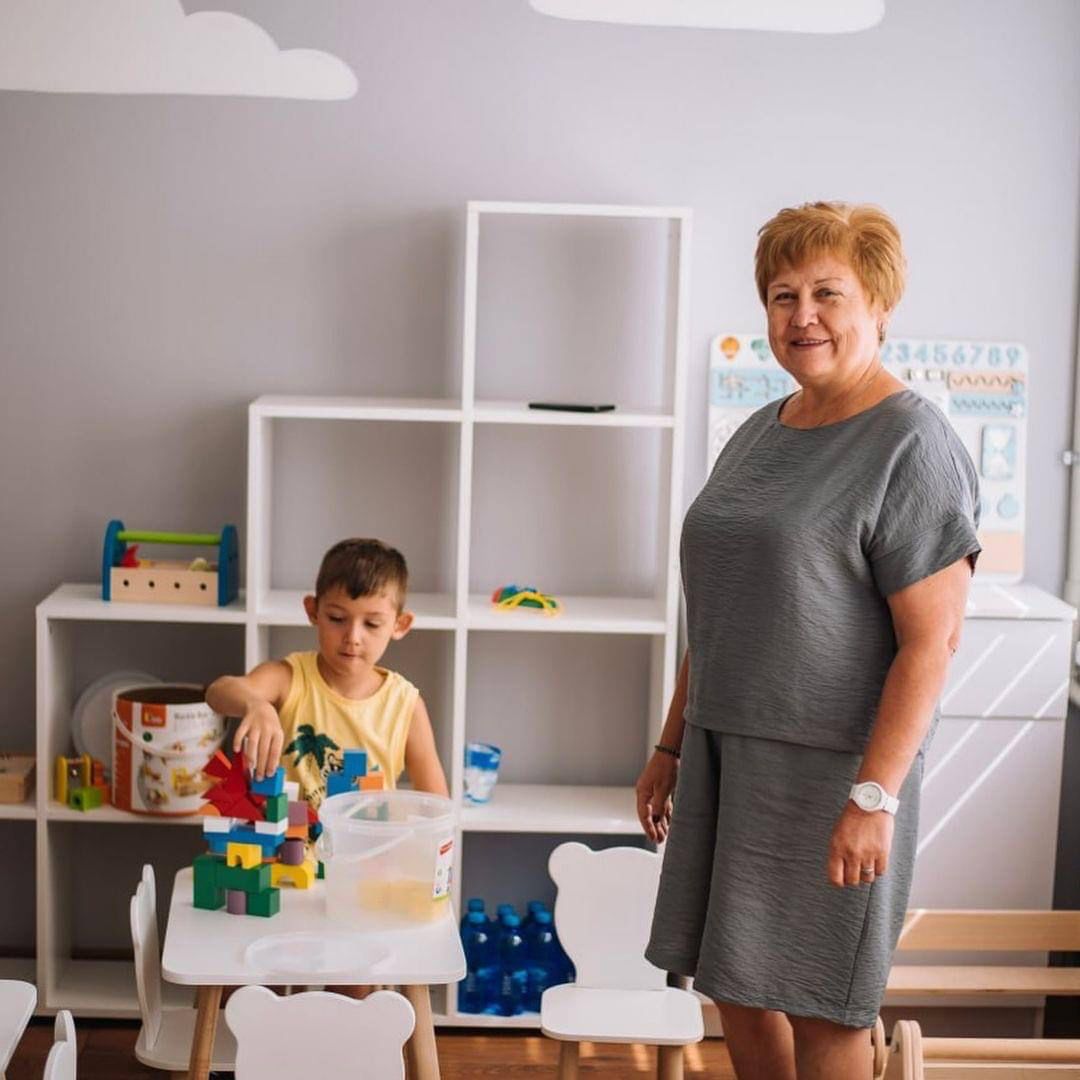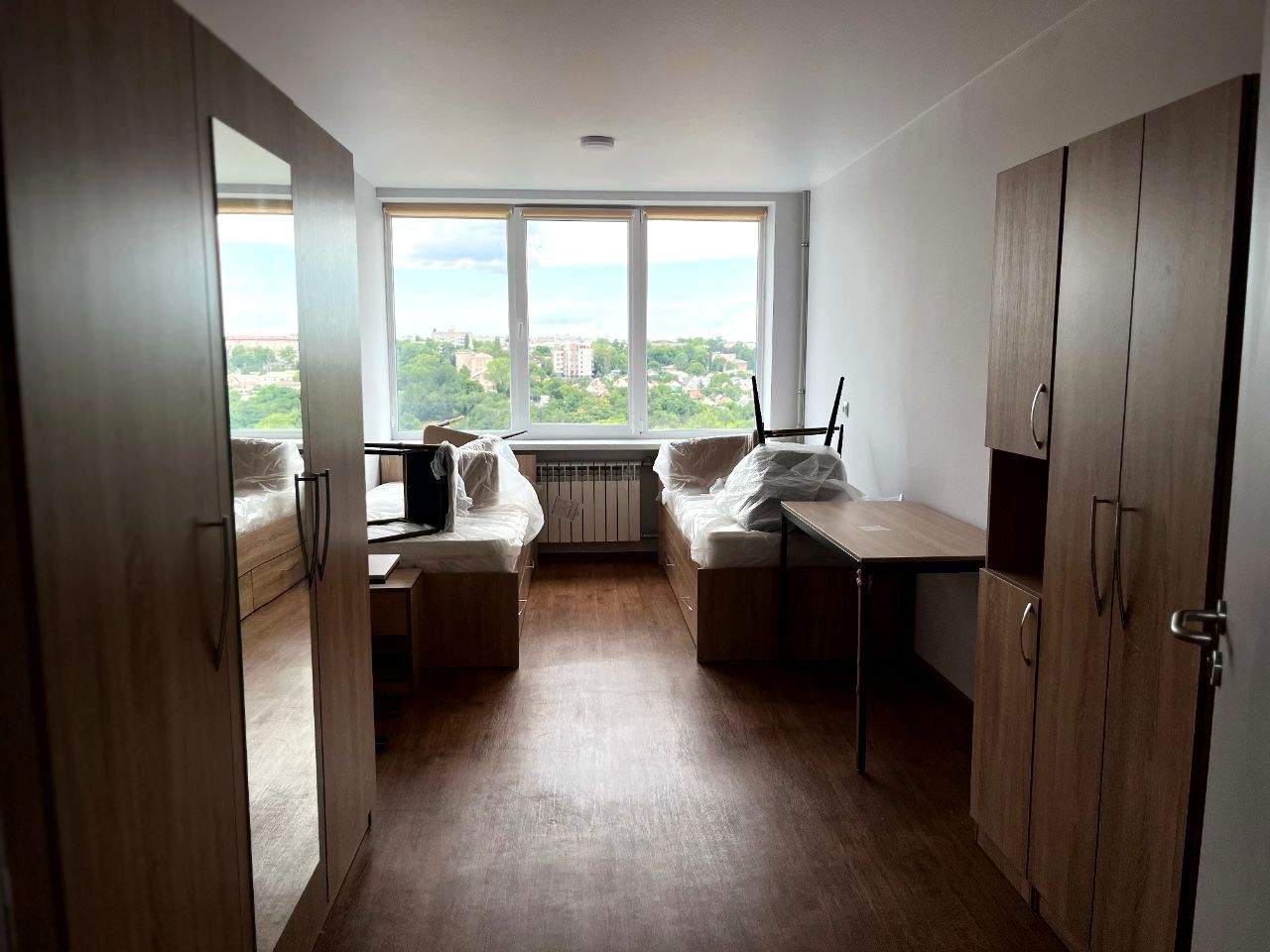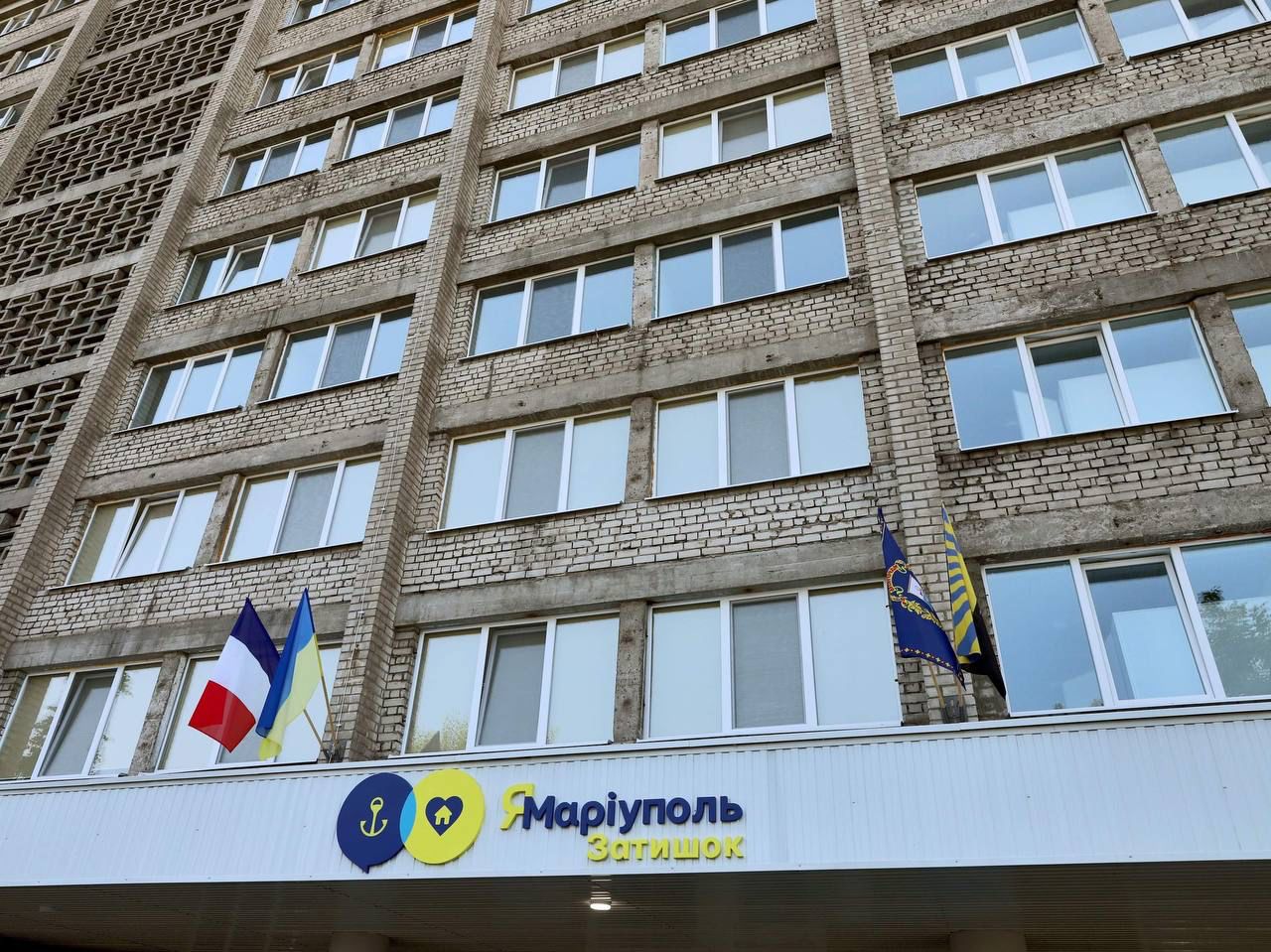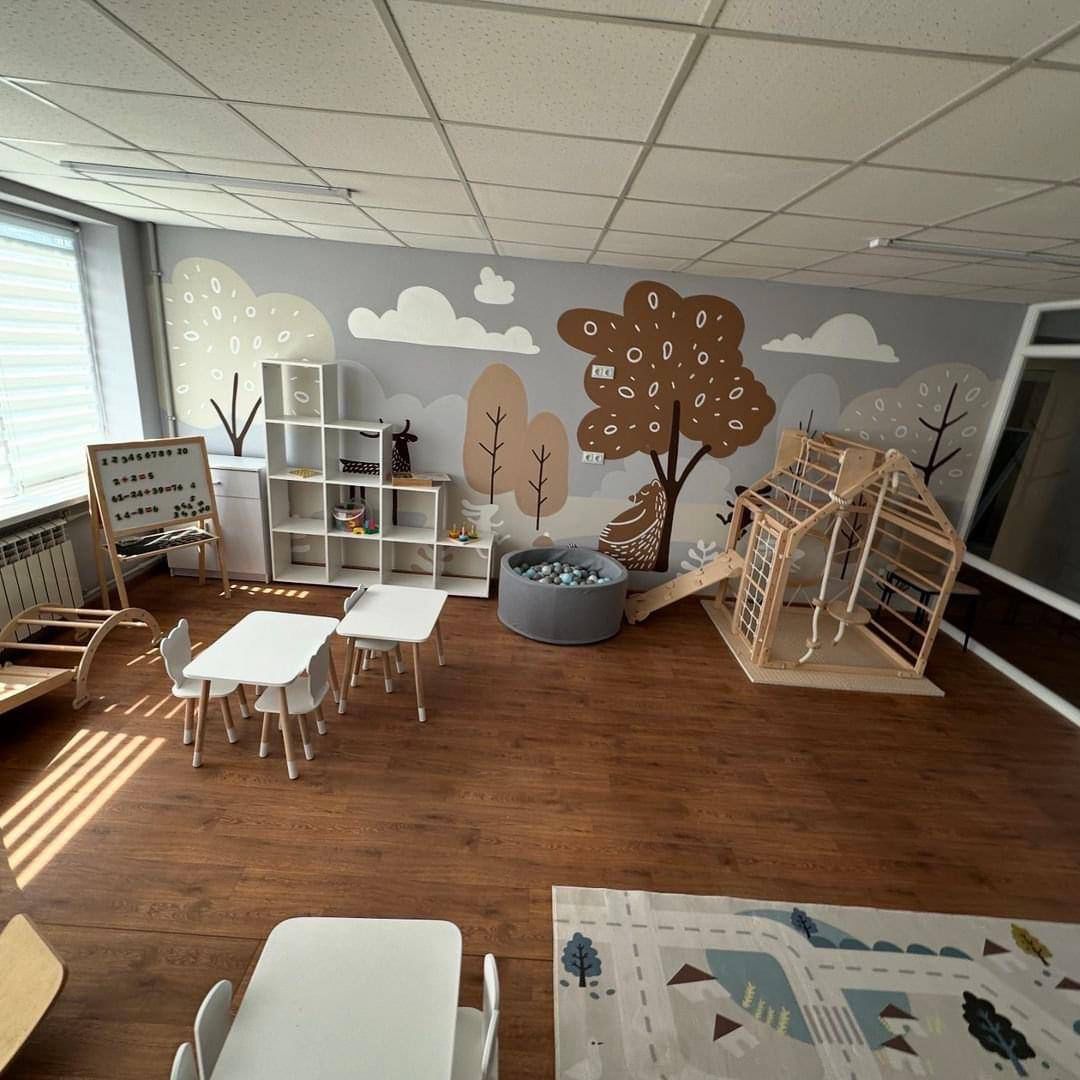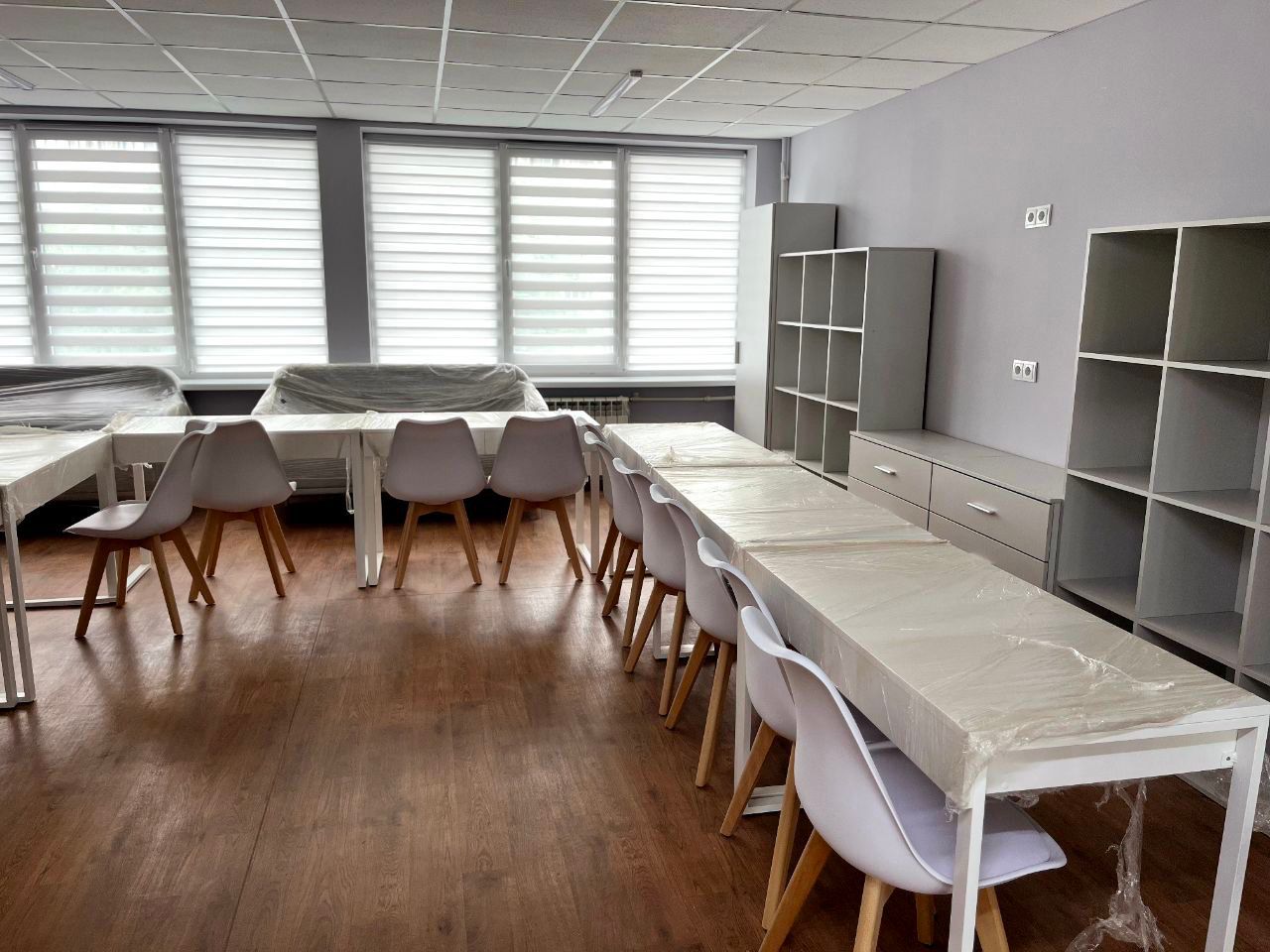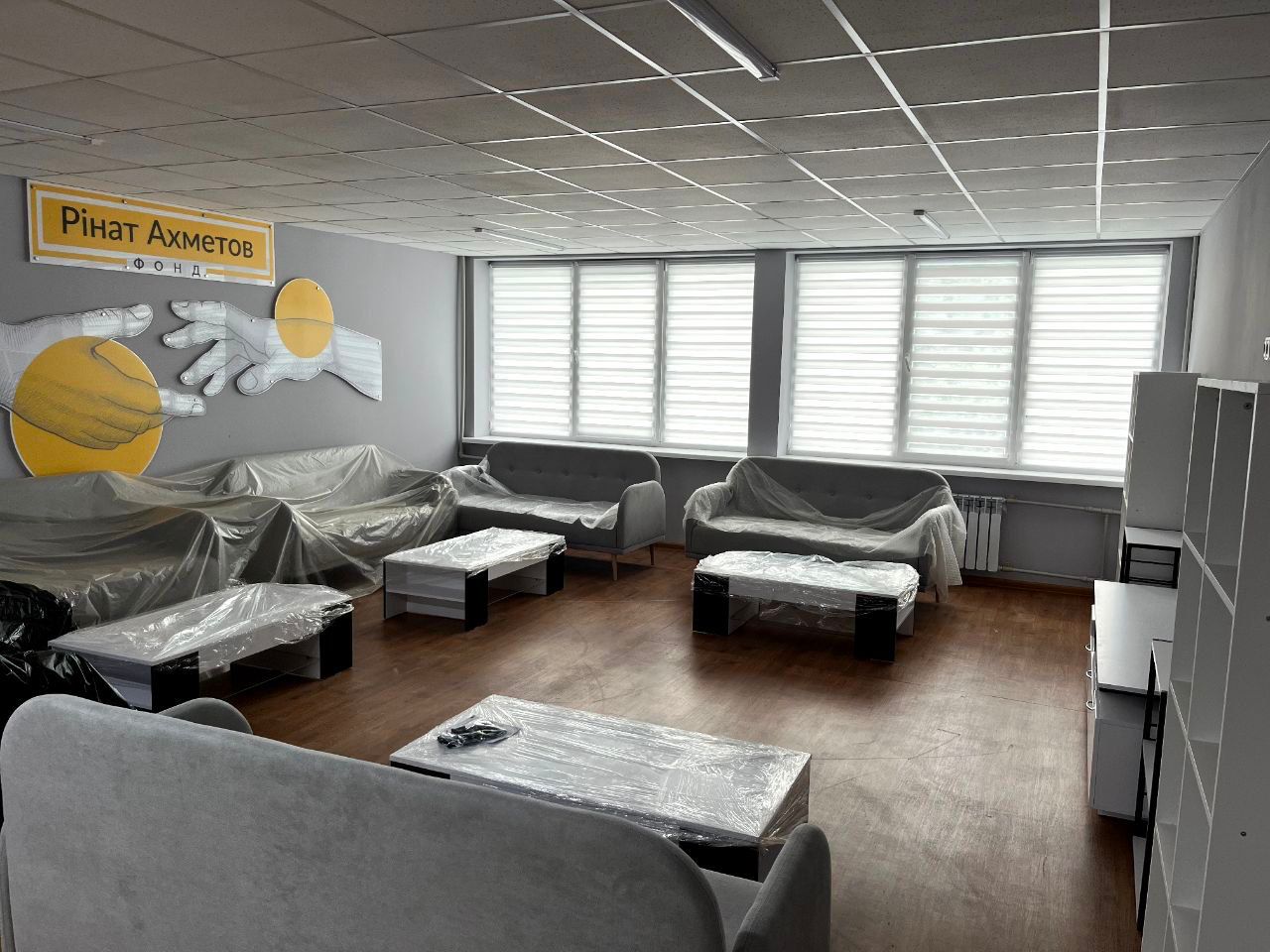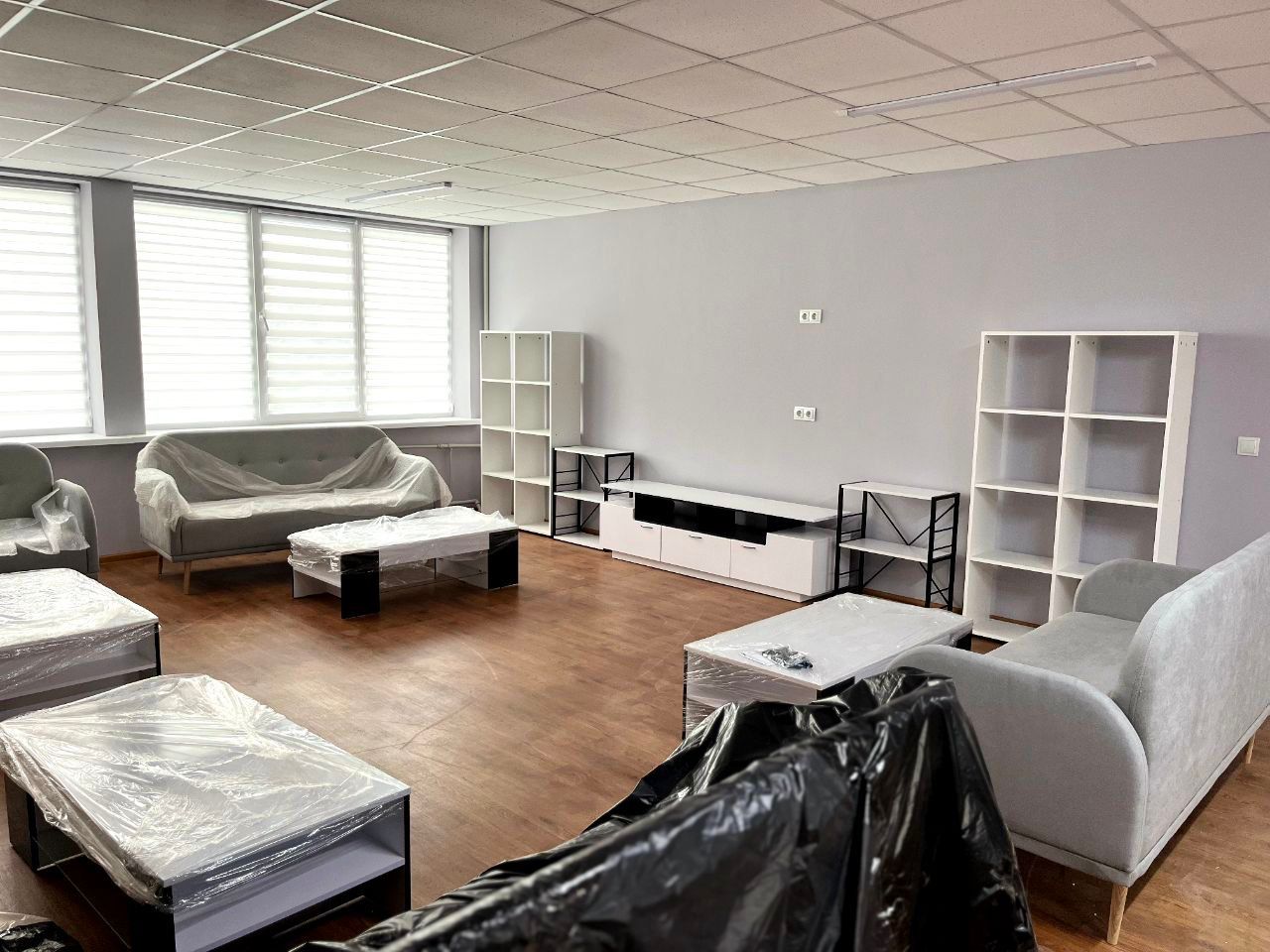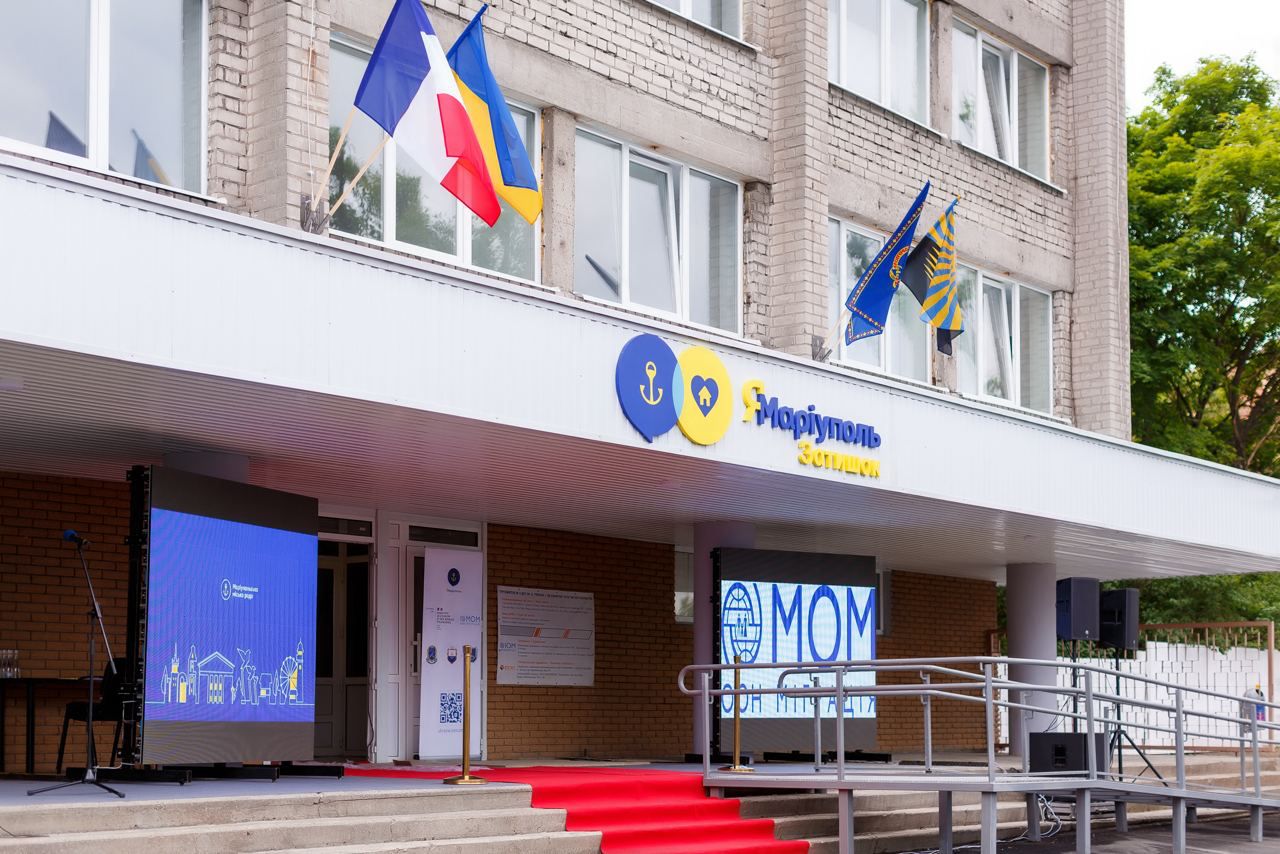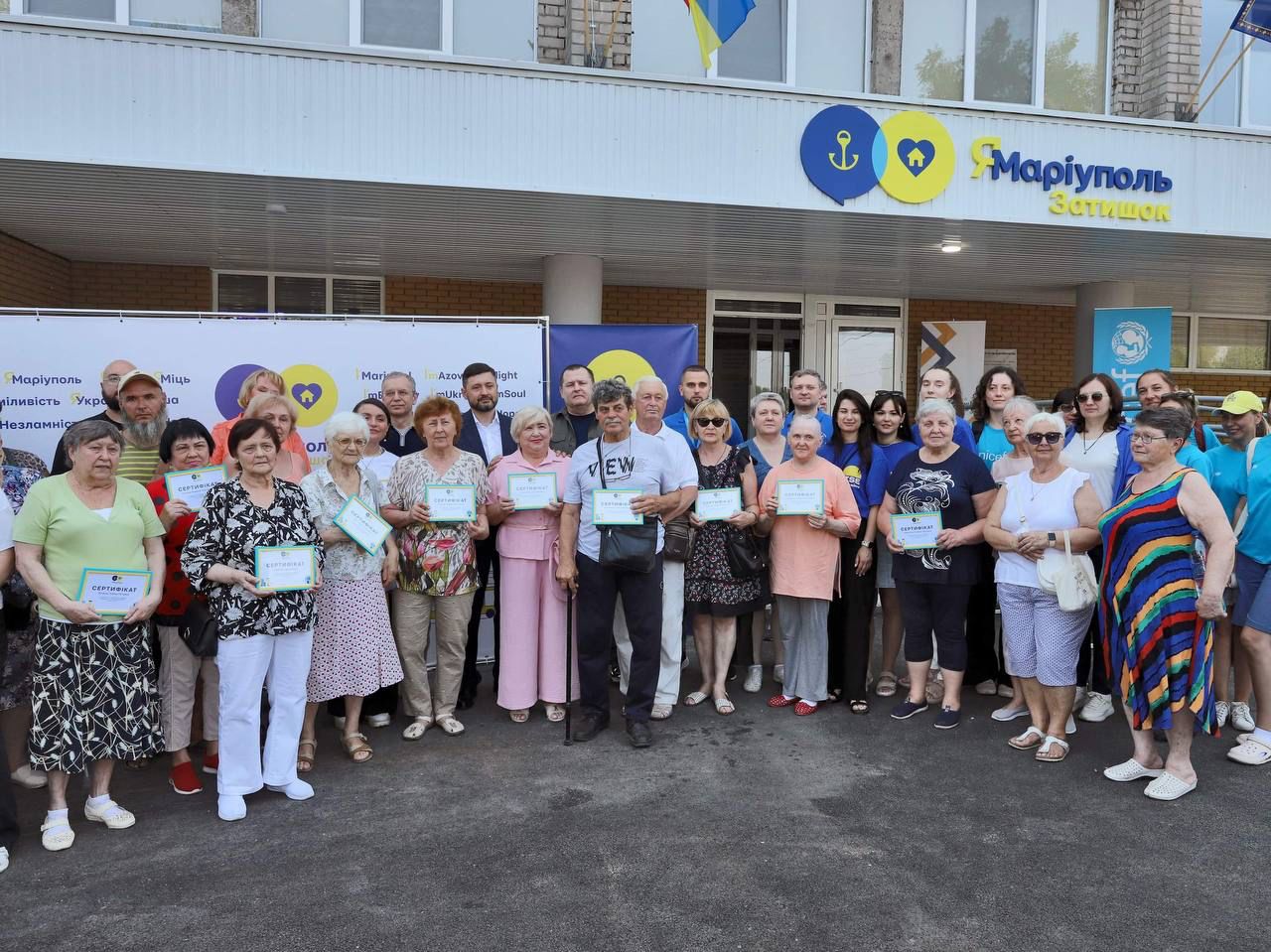Prioritising the places and people that need it the most
«I’Mariupol. Housing»
“I'Mariupol. Housing” is a social housing project for internally displaced persons from Mariupol.
‘I’Mariupol. Housing’ - is a unique programme for the renovation of abandoned buildings into modern social housing with comfortable living conditions for internally displaced persons from the temporarily occupied Mariupol, Donetsk region, Ukraine.
Successfully repaired and renovated into social housing, a 10-story building in Dnipro, Ukraine, with a total area of 4700 square meters, provides 228 modern smart apartments for the 680 Mariupol residents from vulnerable categories of IDPs.
Successfully repaired and renovated into social housing, a 10-story building in Dnipro, Ukraine, with a total area of 4700 square meters, provides 228 modern smart apartments for the 680 Mariupol residents from vulnerable categories of IDPs.
Ukraine
Local
Dnipro city
Mainly urban
It refers to a physical transformation of the built environment (hard investment)
Yes
2024-07-31
Yes
The project was implemented with the support of the Government of France, the International Organization for Migration (IOM), and UNHCR Ukraine, the United Nations High Commissioner for Refugees in Ukraine, in 2023-2024.
No
No
As a representative of an organisation
According to the 2024 nationwide sociological study 'Current Issues of IDPs' in Ukraine, conducted with the support of the UK Government, 85% of internally displaced persons (IDPs) identify housing as a critical issue. In addition, 97% lack housing due to destruction or occupation, and 67% spend more than half their income on rent. High rental costs in host communities force many IDPs to move to EU countries that offer financial assistance and free housing. Housing insecurity causes stress, insecurity and instability, especially for vulnerable groups with limited income.
The "I'Mariupol. Housing" project aims to create modern social housing for IDPs from temporarily occupied Mariupol by renovating abandoned buildings.
Target group:
IDPs from Mariupol, including large families, the elderly, people with disabilities, military families, relatives of prisoners of war and educators.
Main objectives:
1. To address the critical shelter needs of Mariupol IDPs.
2. To provide comfortable living conditions and community spaces.
3. Support IDP adaptation through social, work and educational spaces.
4. Renovate existing dormitories instead of building new ones, optimising costs and promoting sustainable construction.
5. Preventing emigration of the population abroad, preserving human capital for Ukraine's recovery.
6. Develop a scalable housing crisis model for other regions.
Project achievements:
1. Conversion of a 10-storey university dormitory (4,700 m²) into 228 smart apartments for 628 residents.
2. Created a high quality communal space with comfortable rooms, kitchens, dining areas, play areas and co-working spaces.
3. Helped alleviate the housing crisis, where 97% of IDPs are homeless and 67% spend more than half their income on rent.
4. Ensured 80% resident satisfaction (survey results).
This project provides a sustainable solution to Ukraine's housing crisis, preventing displacement and promoting economic stability.
The "I'Mariupol. Housing" project aims to create modern social housing for IDPs from temporarily occupied Mariupol by renovating abandoned buildings.
Target group:
IDPs from Mariupol, including large families, the elderly, people with disabilities, military families, relatives of prisoners of war and educators.
Main objectives:
1. To address the critical shelter needs of Mariupol IDPs.
2. To provide comfortable living conditions and community spaces.
3. Support IDP adaptation through social, work and educational spaces.
4. Renovate existing dormitories instead of building new ones, optimising costs and promoting sustainable construction.
5. Preventing emigration of the population abroad, preserving human capital for Ukraine's recovery.
6. Develop a scalable housing crisis model for other regions.
Project achievements:
1. Conversion of a 10-storey university dormitory (4,700 m²) into 228 smart apartments for 628 residents.
2. Created a high quality communal space with comfortable rooms, kitchens, dining areas, play areas and co-working spaces.
3. Helped alleviate the housing crisis, where 97% of IDPs are homeless and 67% spend more than half their income on rent.
4. Ensured 80% resident satisfaction (survey results).
This project provides a sustainable solution to Ukraine's housing crisis, preventing displacement and promoting economic stability.
Social housing
Refugees, internally displaced persons
Circular construction
Reconstruction
Dormitory
The "I’Mariupol. Housing" project exemplifies sustainable development, combining environmental and economic resilience in accordance with the principles of the New European Bauhaus (NEB). It focuses on efficient resource use, long-term housing solutions, and economic stability for internally displaced persons (IDPs).
How the Project Implements the Principle of Sustainability:
1. Renovating abandoned buildings instead of new construction reduces the environmental footprint and decreases the consumption of natural resources.
2. Use of energy-efficient solutions, including modern thermal insulation, airtight windows, LED lighting, and optimized energy consumption.
3. Shared spaces (kitchens, co-working areas, dining rooms) ensure efficient use of energy and material resources.
4. Social dormitories provide IDPs with free housing, which is critical, as 67% of displaced persons spend more than half of their income on rent.
5. Co-working spaces with laptops and internet access facilitate employment opportunities and economic self-sufficiency for residents.
6. The model of renovating abandoned buildings can be scaled to other regions of Ukraine, creating sustainable social housing solutions. The 'I am Mariupol. Housing' team is not stopping and is currently working on expanding the project to a national level to other cities in Ukraine: Lviv, Zaporizhia, Kropyvnytsky, Chernivtsi, Ivano-Frankivsk and Kyiv.
The Project as a Model of Sustainable Development within the NEB Context:
Environmental sustainability – renovation instead of new construction, energy-efficient technologies.
Long-term viability – housing as a permanent and sustainable solution.
Economic resilience – reducing the financial burden on IDPs and supporting economic integration.
"I’Mariupol. Housing" demonstrates how NEB’s sustainability principles can be applied to address housing challenges, creating long-term, economically and environmentally efficient solutions.
How the Project Implements the Principle of Sustainability:
1. Renovating abandoned buildings instead of new construction reduces the environmental footprint and decreases the consumption of natural resources.
2. Use of energy-efficient solutions, including modern thermal insulation, airtight windows, LED lighting, and optimized energy consumption.
3. Shared spaces (kitchens, co-working areas, dining rooms) ensure efficient use of energy and material resources.
4. Social dormitories provide IDPs with free housing, which is critical, as 67% of displaced persons spend more than half of their income on rent.
5. Co-working spaces with laptops and internet access facilitate employment opportunities and economic self-sufficiency for residents.
6. The model of renovating abandoned buildings can be scaled to other regions of Ukraine, creating sustainable social housing solutions. The 'I am Mariupol. Housing' team is not stopping and is currently working on expanding the project to a national level to other cities in Ukraine: Lviv, Zaporizhia, Kropyvnytsky, Chernivtsi, Ivano-Frankivsk and Kyiv.
The Project as a Model of Sustainable Development within the NEB Context:
Environmental sustainability – renovation instead of new construction, energy-efficient technologies.
Long-term viability – housing as a permanent and sustainable solution.
Economic resilience – reducing the financial burden on IDPs and supporting economic integration.
"I’Mariupol. Housing" demonstrates how NEB’s sustainability principles can be applied to address housing challenges, creating long-term, economically and environmentally efficient solutions.
Goals:
1. Create a harmonious, aesthetically appealing, functional, and comfortable space that fosters a sense of security and recovery after the stress of evacuation from occupied territories and the loss of a home:
- Use of natural colors, soft lighting, and eco-friendly materials to create a cozy atmosphere.
- Soundproofing between rooms to ensure privacy.
- Creation of an indoor play area within the renovated social dormitory.
- Equipped shelter for residents' safety in case of missile attacks.
2. Foster a sense of home and belonging, which contributes to psychological stability and social adaptation:
- Decoration of public spaces with symbols and visual elements associated with residents' home cities (paintings, colors, mosaics, ornaments).
- Implementation of biophilic design elements (live plants, natural motifs) to help reduce anxiety.
3. Ensure a well-organized and comfortable space that facilitates adaptation and efficient use of housing:
- Clear zoning (living rooms, kitchens, relaxation areas, children's spaces, workspaces).
- Ergonomic kitchen and sanitary areas, designed for shared use without congestion or discomfort.
4. Create an environment that encourages communication and mutual support, fostering adaptation and social integration:
- Establishment of shared spaces (co-working area, leisure zone, children's space).
5. Provide an accessible environment for all, including the elderly, children, and people with limited mobility:
- Universal design features (wide doorways, ramps).
- Adaptable transformer furniture to meet diverse user needs.
The project serves as a model for communities hosting internally displaced persons (IDPs) by addressing their key needs holistically: housing, security, comfort, and support for vulnerable groups. It provides those who have lost their homes due to war with a sense of care and solidarity within Ukrainian society
1. Create a harmonious, aesthetically appealing, functional, and comfortable space that fosters a sense of security and recovery after the stress of evacuation from occupied territories and the loss of a home:
- Use of natural colors, soft lighting, and eco-friendly materials to create a cozy atmosphere.
- Soundproofing between rooms to ensure privacy.
- Creation of an indoor play area within the renovated social dormitory.
- Equipped shelter for residents' safety in case of missile attacks.
2. Foster a sense of home and belonging, which contributes to psychological stability and social adaptation:
- Decoration of public spaces with symbols and visual elements associated with residents' home cities (paintings, colors, mosaics, ornaments).
- Implementation of biophilic design elements (live plants, natural motifs) to help reduce anxiety.
3. Ensure a well-organized and comfortable space that facilitates adaptation and efficient use of housing:
- Clear zoning (living rooms, kitchens, relaxation areas, children's spaces, workspaces).
- Ergonomic kitchen and sanitary areas, designed for shared use without congestion or discomfort.
4. Create an environment that encourages communication and mutual support, fostering adaptation and social integration:
- Establishment of shared spaces (co-working area, leisure zone, children's space).
5. Provide an accessible environment for all, including the elderly, children, and people with limited mobility:
- Universal design features (wide doorways, ramps).
- Adaptable transformer furniture to meet diverse user needs.
The project serves as a model for communities hosting internally displaced persons (IDPs) by addressing their key needs holistically: housing, security, comfort, and support for vulnerable groups. It provides those who have lost their homes due to war with a sense of care and solidarity within Ukrainian society
The project is aimed at supporting the most vulnerable categories of IDPs, including large families, people with disabilities, pregnant women, pensioners, former prisoners of war, combat veterans, and relatives of those who died as a result of military actions. Applicants for social housing were selected on the basis of a point system, which is the most transparent way of allocating housing to refugees and removes the influence of the human factor. In this way, housing is allocated to those who need it most.
In wartime conditions, basic social and household services have become less accessible, so an essential goal of the project is to provide residents not only with housing but also to uphold critical principles:
1. Accessibility for all:
- Barrier-free access (buildings are equipped with ramps, wide doorways, and elevators for people with limited mobility).
- Adapted sanitary conditions (a specially equipped toilet and six restrooms for people with disabilities).
- Inclusive interior design (special rooms with equipment for individuals with limited physical abilities).
2. Inclusive social services:
A "resilience space" has been created within the social housing facility, offering a comprehensive range of services, including psychological support, psychosocial adaptation and rehabilitation, social case management for children and adults, and legal assistance.
3. Community building and social cohesion:
- Uniting displaced persons in a shared living environment that recreates their familiar community experience from Mariupol.
- Joint activities in residential spaces help residents feel supported and reduce social isolation.
The "I’Mariupol. Housing" project exemplifies a model approach to inclusion, ensuring equal opportunities, accessibility, and social support for all residents.
In wartime conditions, basic social and household services have become less accessible, so an essential goal of the project is to provide residents not only with housing but also to uphold critical principles:
1. Accessibility for all:
- Barrier-free access (buildings are equipped with ramps, wide doorways, and elevators for people with limited mobility).
- Adapted sanitary conditions (a specially equipped toilet and six restrooms for people with disabilities).
- Inclusive interior design (special rooms with equipment for individuals with limited physical abilities).
2. Inclusive social services:
A "resilience space" has been created within the social housing facility, offering a comprehensive range of services, including psychological support, psychosocial adaptation and rehabilitation, social case management for children and adults, and legal assistance.
3. Community building and social cohesion:
- Uniting displaced persons in a shared living environment that recreates their familiar community experience from Mariupol.
- Joint activities in residential spaces help residents feel supported and reduce social isolation.
The "I’Mariupol. Housing" project exemplifies a model approach to inclusion, ensuring equal opportunities, accessibility, and social support for all residents.
Citizens who benefit from the "I'Mariupol. Housing" project, as well as civil society, have been actively involved at all stages of its implementation. The "I'Mariupol" Charitable Foundation, in cooperation with the Mariupol City Council, Ukrainian and international donors, has established a network of 28 support centers for internally displaced persons (IDPs) in 19 cities across Ukraine. Through these centers, more than 63,000 Mariupol residents and IDPs from the Donetsk region receive psychological, legal, medical, and humanitarian assistance, as well as employment support.
The "I'Mariupol" centers not only provide social support but also serve as platforms for communication among Mariupol residents, allowing them to express their opinions and submit proposals regarding social housing needs. Through these centers, feedback has been gathered on housing arrangements, necessary services, and additional amenities. The results of these discussions form a comprehensive needs map, which serves as a foundation for developing housing standards for both completed and planned renovation projects.
Thanks to the direct participation of citizens, the project organizers obtain crucial social data, including the gender composition of housing applicants, their health status, and specific needs, ensuring the creation of more inclusive and comfortable living environments. Additionally, after moving in, residents can provide continuous feedback, allowing for the timely improvement of services and adaptation of housing conditions based on evolving needs. This approach ensures effective interaction between beneficiaries, civil society, and project organizers, making the initiative as responsive as possible to people's actual needs.
The "I'Mariupol" centers not only provide social support but also serve as platforms for communication among Mariupol residents, allowing them to express their opinions and submit proposals regarding social housing needs. Through these centers, feedback has been gathered on housing arrangements, necessary services, and additional amenities. The results of these discussions form a comprehensive needs map, which serves as a foundation for developing housing standards for both completed and planned renovation projects.
Thanks to the direct participation of citizens, the project organizers obtain crucial social data, including the gender composition of housing applicants, their health status, and specific needs, ensuring the creation of more inclusive and comfortable living environments. Additionally, after moving in, residents can provide continuous feedback, allowing for the timely improvement of services and adaptation of housing conditions based on evolving needs. This approach ensures effective interaction between beneficiaries, civil society, and project organizers, making the initiative as responsive as possible to people's actual needs.
The implementation of the project would have been significantly more challenging without the active participation of stakeholders at various levels.
At the local level, the project was initiated by the Mariupol municipality, led by Mayor Vadym Boichenko, while Oles Honchar Dnipro National University provided premises for the establishment of a social dormitory.
To enhance trust among international partners, a new transparent cooperation model was introduced. According to this model, the Mariupol City Council defines the project requirements and technical specifications, while the donor independently selects the contractor, oversees tenders, and controls financial matters.
At the regional level, the project was launched with the support of Pavlo Kyrylenko, Head of the Donetsk Military Administration, ensuring its integration into state programs for internally displaced persons (IDPs).
At the national level, financial support was provided by Ukrainian organizations, including the Rinat Akhmetov Foundation and SCM Limited.
At the European level, the Government of France provided additional funding, while the International Organization for Migration (IOM) took responsibility for project planning, cooperation with contractors and suppliers, and operational oversight.
The role of the Mariupol municipality and state authorities includes acting as project commissioners and making final decisions on its implementation. The involvement of international partners ensures high execution standards, improving the quality of work.
This multi-level approach guarantees transparency, high implementation quality, and oversight by a broad range of stakeholders. Cooperation among different parties optimizes resource allocation and ensures that the project meets the needs of internally displaced persons.
At the local level, the project was initiated by the Mariupol municipality, led by Mayor Vadym Boichenko, while Oles Honchar Dnipro National University provided premises for the establishment of a social dormitory.
To enhance trust among international partners, a new transparent cooperation model was introduced. According to this model, the Mariupol City Council defines the project requirements and technical specifications, while the donor independently selects the contractor, oversees tenders, and controls financial matters.
At the regional level, the project was launched with the support of Pavlo Kyrylenko, Head of the Donetsk Military Administration, ensuring its integration into state programs for internally displaced persons (IDPs).
At the national level, financial support was provided by Ukrainian organizations, including the Rinat Akhmetov Foundation and SCM Limited.
At the European level, the Government of France provided additional funding, while the International Organization for Migration (IOM) took responsibility for project planning, cooperation with contractors and suppliers, and operational oversight.
The role of the Mariupol municipality and state authorities includes acting as project commissioners and making final decisions on its implementation. The involvement of international partners ensures high execution standards, improving the quality of work.
This multi-level approach guarantees transparency, high implementation quality, and oversight by a broad range of stakeholders. Cooperation among different parties optimizes resource allocation and ensures that the project meets the needs of internally displaced persons.
The development and implementation of the project brought together specialists from various disciplines and fields of knowledge, ensuring a comprehensive approach and high-quality execution.
Architecture and construction played a key role in renovating abandoned buildings into modern social housing. Designers and engineers collaborated with contractors to optimize space and resources while adhering to modern environmental standards.
Sociology and social work were essential in identifying the real needs of internally displaced persons (IDPs). Through the network of "I'Mariupol" centers, surveys and data collection were conducted to assess housing conditions, social integration, and the daily needs of future residents.
Economics and finance were involved in budgeting, identifying funding sources, and ensuring efficient use of resources. National and international partners coordinated financial contributions, enabling the project to be implemented through co-financing from multiple sources.
International relations and law facilitated cooperation with European partners, including the French government and the International Organization for Migration. Legal experts ensured compliance with Ukrainian legislation and international standards.
Project management and strategic planning integrated all these fields to coordinate processes, make decisions, and oversee implementation.
Thanks to interdisciplinary collaboration, an effective model of social housing was created, taking into account not only construction and financial aspects but also social adaptation and long-term sustainability. This approach provided a comprehensive solution to the housing crisis for IDPs and laid the foundation for further scaling of the project.
Architecture and construction played a key role in renovating abandoned buildings into modern social housing. Designers and engineers collaborated with contractors to optimize space and resources while adhering to modern environmental standards.
Sociology and social work were essential in identifying the real needs of internally displaced persons (IDPs). Through the network of "I'Mariupol" centers, surveys and data collection were conducted to assess housing conditions, social integration, and the daily needs of future residents.
Economics and finance were involved in budgeting, identifying funding sources, and ensuring efficient use of resources. National and international partners coordinated financial contributions, enabling the project to be implemented through co-financing from multiple sources.
International relations and law facilitated cooperation with European partners, including the French government and the International Organization for Migration. Legal experts ensured compliance with Ukrainian legislation and international standards.
Project management and strategic planning integrated all these fields to coordinate processes, make decisions, and oversee implementation.
Thanks to interdisciplinary collaboration, an effective model of social housing was created, taking into account not only construction and financial aspects but also social adaptation and long-term sustainability. This approach provided a comprehensive solution to the housing crisis for IDPs and laid the foundation for further scaling of the project.
The innovative nature of the project lies in the fact that the approach to housing refugees within the host country is a unique experience. Unfortunately, this experience is caused by the most terrible event - the war.
Instead of the traditional construction of new residential complexes, which requires significant resources, the project implements the concept of renovation of abandoned buildings. This allows not only to quickly provide housing for displaced persons, but also to breathe new life into objects that were no longer used for their original purpose. Thus, the project reduces the cost of new construction, minimizes the environmental burden and has a positive impact on the urban space.
As a result of this strategy, communities not only receive IDPs, but also receive renovated residential facilities, which after the war can be used for other social needs. This helps to reduce the number of abandoned buildings in cities, reduces the cost of their demolition and waste disposal.
Another important innovation is the direct involvement of displaced persons in the planning of living quarters. Through the network of "I-Mariupol" centers, proposals are collected for the arrangement of dormitories, additional services and social infrastructure, which allows to adapt the space as much as possible to the real needs of residents.
In addition to safe and comfortable housing, the project provides integration of social and economic support. The created co-working spaces, access to psychological assistance and socialization programs contribute to faster adaptation of IDPs.
The uniqueness of this model lies in the fact that it can be scaled and adapted in any country in case of similar crisis situations. The project has become not only an effective solution for displaced persons, but also an example of rational use of resources and long-term support for community development.
Instead of the traditional construction of new residential complexes, which requires significant resources, the project implements the concept of renovation of abandoned buildings. This allows not only to quickly provide housing for displaced persons, but also to breathe new life into objects that were no longer used for their original purpose. Thus, the project reduces the cost of new construction, minimizes the environmental burden and has a positive impact on the urban space.
As a result of this strategy, communities not only receive IDPs, but also receive renovated residential facilities, which after the war can be used for other social needs. This helps to reduce the number of abandoned buildings in cities, reduces the cost of their demolition and waste disposal.
Another important innovation is the direct involvement of displaced persons in the planning of living quarters. Through the network of "I-Mariupol" centers, proposals are collected for the arrangement of dormitories, additional services and social infrastructure, which allows to adapt the space as much as possible to the real needs of residents.
In addition to safe and comfortable housing, the project provides integration of social and economic support. The created co-working spaces, access to psychological assistance and socialization programs contribute to faster adaptation of IDPs.
The uniqueness of this model lies in the fact that it can be scaled and adapted in any country in case of similar crisis situations. The project has become not only an effective solution for displaced persons, but also an example of rational use of resources and long-term support for community development.
The methodology and approach used in the "I’Mariupol. Housing" project are based on a comprehensive combination of urban planning, social, and inclusive practices. The main goal is to create sustainable, safe, and accessible housing for internally displaced persons (IDPs), considering the needs of different social groups.
The project follows the principle of adaptive reuse of buildings, allowing the renovation of abandoned dormitories instead of constructing new ones. This approach reduces costs, minimizes the environmental footprint, and speeds up implementation. The modernization process complies with modern energy efficiency standards, including facade insulation, upgrading engineering networks, and installing cost-effective lighting and heating systems.
The living space is designed with a human-centered approach. It includes comfortable residential units, as well as social, educational, and workspaces, which facilitate the adaptation and integration of residents into the local community. The housing is adapted to accommodate all categories of IDPs, including families with children, the elderly, and people with disabilities. The application of universal design principles, such as barrier-free access, ramps, elevators, and adapted restrooms, ensures equal opportunities for all residents. Additionally, each dormitory is equipped with a shelter to provide safety in case of emergency situations.
The project also focuses on creating spaces for social interaction. Shared areas such as children’s rooms, co-working spaces, and recreational zones help foster community cohesion and mutual support. A key aspect of the initiative is psychosocial assistance, provided by psychologists, lawyers, and social workers.
The developed model is scalable and can be replicated in other cities across Ukraine. Through collaboration with municipal authorities, the project is integrated into urban housing programs, creating long-term solutions for displaced persons.
The project follows the principle of adaptive reuse of buildings, allowing the renovation of abandoned dormitories instead of constructing new ones. This approach reduces costs, minimizes the environmental footprint, and speeds up implementation. The modernization process complies with modern energy efficiency standards, including facade insulation, upgrading engineering networks, and installing cost-effective lighting and heating systems.
The living space is designed with a human-centered approach. It includes comfortable residential units, as well as social, educational, and workspaces, which facilitate the adaptation and integration of residents into the local community. The housing is adapted to accommodate all categories of IDPs, including families with children, the elderly, and people with disabilities. The application of universal design principles, such as barrier-free access, ramps, elevators, and adapted restrooms, ensures equal opportunities for all residents. Additionally, each dormitory is equipped with a shelter to provide safety in case of emergency situations.
The project also focuses on creating spaces for social interaction. Shared areas such as children’s rooms, co-working spaces, and recreational zones help foster community cohesion and mutual support. A key aspect of the initiative is psychosocial assistance, provided by psychologists, lawyers, and social workers.
The developed model is scalable and can be replicated in other cities across Ukraine. Through collaboration with municipal authorities, the project is integrated into urban housing programs, creating long-term solutions for displaced persons.
Considering that around 3,000 Mariupol residents have applied to the Mariupol City Council for social housing, the implementation of the "I Mariupol. Housing" project will be continued in five more buildings in Dnipro, as well as in Lviv, Zaporizhzhia, Kropyvnytskyi, Chernivtsi, Ivano-Frankivsk, and Kyiv.
The "I’Mariupol. Housing" project has a high potential for replication and adaptation in other cities in Ukraine and beyond. Its versatility lies in the combination of adaptive building renovation, an inclusive approach, and social integration of residents.
The renovation methodology can be applied in any community with abandoned buildings suitable for restoration. The use of energy-efficient technologies, such as facade insulation, infrastructure upgrades, and the installation of cost-effective heating and lighting systems, can be adapted to different climatic conditions and local resources.
The principles of inclusive design, including barrier-free access, adapted sanitary facilities, and universal spaces for different social groups, can be integrated into any social housing project.
The social model, which includes the creation of shared spaces for communication, coworking areas, children's rooms, and recreational zones, serves as an essential tool for integrating displaced persons into communities. The organization of psychological support, legal consultations, and social assistance can be effective for any group that has experienced crisis situations.
The project model can also be applied to provide housing for veterans, people who have lost their homes due to natural disasters, or other socially vulnerable groups.
"I’Mariupol. Housing" demonstrates an effective approach to creating accessible and comfortable living environments that can be replicated and scaled to meet the needs of any community.
The "I’Mariupol. Housing" project has a high potential for replication and adaptation in other cities in Ukraine and beyond. Its versatility lies in the combination of adaptive building renovation, an inclusive approach, and social integration of residents.
The renovation methodology can be applied in any community with abandoned buildings suitable for restoration. The use of energy-efficient technologies, such as facade insulation, infrastructure upgrades, and the installation of cost-effective heating and lighting systems, can be adapted to different climatic conditions and local resources.
The principles of inclusive design, including barrier-free access, adapted sanitary facilities, and universal spaces for different social groups, can be integrated into any social housing project.
The social model, which includes the creation of shared spaces for communication, coworking areas, children's rooms, and recreational zones, serves as an essential tool for integrating displaced persons into communities. The organization of psychological support, legal consultations, and social assistance can be effective for any group that has experienced crisis situations.
The project model can also be applied to provide housing for veterans, people who have lost their homes due to natural disasters, or other socially vulnerable groups.
"I’Mariupol. Housing" demonstrates an effective approach to creating accessible and comfortable living environments that can be replicated and scaled to meet the needs of any community.
The «I'Mariupol. Housing» project responds to several global challenges by providing effective local solutions that can be scaled and adapted.
One of the key challenges is the global housing crisis. Millions of people have lost their homes due to war, which is part of a wider problem of forced displacement around the world. The project provides rapid housing adaptation through the renovation of abandoned buildings, making efficient use of existing housing stock without the need for long-term construction.
Another challenge is the social integration of IDPs. IDPs face difficulties in finding housing, employment and re-establishing social ties. The project facilitates their adaptation by providing comfortable housing, psychological support, common spaces for leisure and work.
The project also responds to the environmental challenge by promoting the sustainable use of resources. The principle of adaptive reuse of buildings reduces the need for new materials, reduces construction waste and increases energy efficiency.
Another important aspect is urban infrastructure. The solutions offered by the project will allow cities to integrate new residents without overloading utility systems, while maintaining the balance of the urban environment.
Finally, the project addresses the loss of human capital through emigration. By creating affordable housing, the initiative facilitates the return of citizens and prevents migration by providing conditions for living and working in Ukraine.
The «I'Mariupol. Housing» project demonstrates how local solutions can effectively respond to global challenges by creating sustainable, environmentally and socially responsible approaches to housing policy.
One of the key challenges is the global housing crisis. Millions of people have lost their homes due to war, which is part of a wider problem of forced displacement around the world. The project provides rapid housing adaptation through the renovation of abandoned buildings, making efficient use of existing housing stock without the need for long-term construction.
Another challenge is the social integration of IDPs. IDPs face difficulties in finding housing, employment and re-establishing social ties. The project facilitates their adaptation by providing comfortable housing, psychological support, common spaces for leisure and work.
The project also responds to the environmental challenge by promoting the sustainable use of resources. The principle of adaptive reuse of buildings reduces the need for new materials, reduces construction waste and increases energy efficiency.
Another important aspect is urban infrastructure. The solutions offered by the project will allow cities to integrate new residents without overloading utility systems, while maintaining the balance of the urban environment.
Finally, the project addresses the loss of human capital through emigration. By creating affordable housing, the initiative facilitates the return of citizens and prevents migration by providing conditions for living and working in Ukraine.
The «I'Mariupol. Housing» project demonstrates how local solutions can effectively respond to global challenges by creating sustainable, environmentally and socially responsible approaches to housing policy.
Main results:
1. A 10-storey university hall of residence (4,700 m²), which was unused and derelict, was renovated and reconstructed. It has 228 smart apartments with new furniture, two co-working areas, children's rooms, recreation areas, a gym and a secure shelter. Social housing has been provided for 628 people.
Each floor has a communal kitchen with the necessary appliances, two bathrooms (each with 4 toilets, showers and 6 sinks) and washing and drying machines. Fire safety standards are met: fire extinguishers, evacuation plans and first aid kits are installed.
Alternative energy sources are available (generator, 6 EcoFlow charging points). The first floor and toilets are adapted for people with reduced mobility. There is a recreation area in the courtyard. There is a hospital, pharmacy, transport, school and shop within walking distance.
2. Optimized the use of abandoned buildings, enabling the rapid creation of housing without the need for new construction.
3. Provided essential living conditions, including comfortable rooms, a kitchen, a dining area, children's play zones, and co-working spaces with laptops and internet access.
4. Developed a model for integrating IDPs into host communities through housing, social support, and employment opportunities.
Impact on beneficiaries:
1. Direct beneficiaries (IDPs who received housing) gained stability, security, and the opportunity to adapt, significantly improving their psychological well-being.
2. Indirect beneficiaries – local communities – received upgraded infrastructure, which will remain in their ownership after the war.
Long-term impact:
1. Preventing emigration and the loss of human capital by providing affordable housing, reducing the need for skilled professionals to leave the country.
2. The project model can be scaled to other cities in Ukraine and adapted for future housing crises.
1. A 10-storey university hall of residence (4,700 m²), which was unused and derelict, was renovated and reconstructed. It has 228 smart apartments with new furniture, two co-working areas, children's rooms, recreation areas, a gym and a secure shelter. Social housing has been provided for 628 people.
Each floor has a communal kitchen with the necessary appliances, two bathrooms (each with 4 toilets, showers and 6 sinks) and washing and drying machines. Fire safety standards are met: fire extinguishers, evacuation plans and first aid kits are installed.
Alternative energy sources are available (generator, 6 EcoFlow charging points). The first floor and toilets are adapted for people with reduced mobility. There is a recreation area in the courtyard. There is a hospital, pharmacy, transport, school and shop within walking distance.
2. Optimized the use of abandoned buildings, enabling the rapid creation of housing without the need for new construction.
3. Provided essential living conditions, including comfortable rooms, a kitchen, a dining area, children's play zones, and co-working spaces with laptops and internet access.
4. Developed a model for integrating IDPs into host communities through housing, social support, and employment opportunities.
Impact on beneficiaries:
1. Direct beneficiaries (IDPs who received housing) gained stability, security, and the opportunity to adapt, significantly improving their psychological well-being.
2. Indirect beneficiaries – local communities – received upgraded infrastructure, which will remain in their ownership after the war.
Long-term impact:
1. Preventing emigration and the loss of human capital by providing affordable housing, reducing the need for skilled professionals to leave the country.
2. The project model can be scaled to other cities in Ukraine and adapted for future housing crises.

